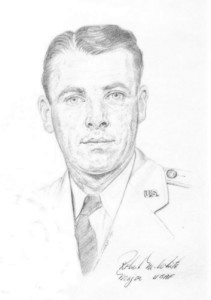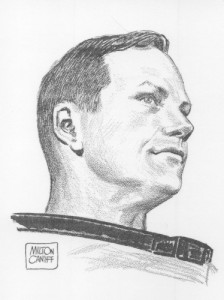Exploring
hypersonic history
by Paul Raveling,
Publication anticipated in Village
Life
in El Dorado Hills, January, 2005
History presents not just a record of the past, but a wealth of
stories to interpret and learn from. In November I indulged my own
focus in aviation and space history with a field trip to
the eastern states. Highlights were long talks with Bob White and Neil
Armstrong, each a
distinguished
research pilot who flew the rocket-powered X-15. Filling out the trip
were archive searches at the National Air and
Space
Museum, NASA headquarters, and the Air Force Museum.
 The X-15 research
program was one of the "giant leaps" of the
twentieth century, acknowledged by the first X-15's residence in NASM's
Milestones of Flight Gallery. North American
Aviation's three X-15s made 199 research flights from 1959 through
1968,
advancing both aviation and space technology. They pushed
the world speed record up from Mach 3.2
to Mach 6.7 -- 6.7 times the speed of sound -- and raised the altitude
record from 126,200 to 354,200
feet, about 67 miles. They were the first to test aerodynamic heating
in winged reentry from space, with parts of the X-15's skin glowing red
hot at
1,200 degrees F. Beneficiaries of their research included Apollo moon
flights and the
Space Shuttle.
The X-15 research
program was one of the "giant leaps" of the
twentieth century, acknowledged by the first X-15's residence in NASM's
Milestones of Flight Gallery. North American
Aviation's three X-15s made 199 research flights from 1959 through
1968,
advancing both aviation and space technology. They pushed
the world speed record up from Mach 3.2
to Mach 6.7 -- 6.7 times the speed of sound -- and raised the altitude
record from 126,200 to 354,200
feet, about 67 miles. They were the first to test aerodynamic heating
in winged reentry from space, with parts of the X-15's skin glowing red
hot at
1,200 degrees F. Beneficiaries of their research included Apollo moon
flights and the
Space Shuttle.
Heavily instrumented X-15s collected masses
of flight test
data at hypersonic speeds, logging more time over Mach 4 than any
winged vehicle until the Space Shuttle. They pioneered hypersonic
stability and control, human
factors, and flight in the vacuum of space. They tested the first
3-axis
inertial guidance in a manned craft. X-15s carried experiments to the
edge of space; one
was
an early star tracker, developing technology for celestial navigation
in
Apollo.
Bob White is Air Force Major General Robert M. White,
Retired. During X-15 flight envelope expansion he became
the
first pilot to fly faster than Mach 4, then Mach 5, then Mach 6. He was
the first of eight X-15 pilots to qualify for astronaut wings, setting
a record of 314,750 feet in 1962. Four decades later that official
world record as a winged aircraft still stands.
In General White's own words, "My flights to
217,000 feet
and 314,750 feet were very dramatic in revealing the earth's curvature
... at my highest altitude I could turn my head
through
a 180º arc and wow! - the earth is really round. At my peak
altitude
I was roughly over the Arizona/California border in the area of Las
Vegas ... Looking to my left I felt I
could
spit into the Gulf of California. Looking to my right I felt I
could
toss a dime into San Francisco Bay."
General White had a long and distinguished career in Air Force
aviation. His later career included command of the Air Force Flight
Test Center at Edwards Air Force
Base
and heading program management to develop the F-15 fighter. Most
biographic
summaries say he was shot down over southern Germany in
1945, but that's only a shadow of the story.
In truth he was finishing low altitude
pursuit
of a Messerschmitt 109, close on its tail while gunning it down.
Debris from the Me-109 flew back and hit his his P-51 Mustang, yielding
a flood of oil from his engine that instantly covered the canopy.
He
quickly jettisoned the canopy and tried to climb, realizing that the
engine
would soon seize. He exited with a standard
Mustang bailout, diving over the right wing and hurtling
just
under the horizontal stabilizer. Pulling the rip cord as soon as he was
clear, his feet hit tree tops just as the parachute popped open.
 Neil Armstrong had a
classic adventure in an X-15 flight, producing
a research result that changed reentry planning for both the
X-15
and the Space Shuttle. In performing a planned pullup maneuver on
reentry he skipped off the atmosphere, zooming back into air so thin
that it's effectively space. He shot past Edwards
AFB
at just over 100,000 feet and Mach 3, unable turn back for lack of air
to
generate
aerodynamic force. As the X-15 finally dropped into denser air
Armstrong
established a 3 G turn but still overshot by 45 miles, overflying
Pasadena before heading back toward Rogers Dry Lake. He stretched his
glide to the max, dropping no less than 9,000 feet per minute, and
barely made it. A chase pilot reported his clearance
from
the joshua trees at the edge of the lakebed as "about 100 feet -- on
either
side".
Neil Armstrong had a
classic adventure in an X-15 flight, producing
a research result that changed reentry planning for both the
X-15
and the Space Shuttle. In performing a planned pullup maneuver on
reentry he skipped off the atmosphere, zooming back into air so thin
that it's effectively space. He shot past Edwards
AFB
at just over 100,000 feet and Mach 3, unable turn back for lack of air
to
generate
aerodynamic force. As the X-15 finally dropped into denser air
Armstrong
established a 3 G turn but still overshot by 45 miles, overflying
Pasadena before heading back toward Rogers Dry Lake. He stretched his
glide to the max, dropping no less than 9,000 feet per minute, and
barely made it. A chase pilot reported his clearance
from
the joshua trees at the edge of the lakebed as "about 100 feet -- on
either
side".
All twelve X-15 pilots were engineers, and Neil Armstrong is one
of
those who was an engineer first, a research pilot second. He
constantly contributed to ground-bound engineering as well as to
flight test, starting with the X-1B rocket plane in the early
1950s.
A later example was preflight analysis of Apollo's drogue parachute,
which would open at supersonic speed after reentry. An engineer's first
thoughts
are "Won't that produce a chaotic pattern of shock waves impinging on
the
flexible airfoil? Will it work???"
Armstrong's analysis
showed
it was safe, helping to clear Apollo for flight.
Robert White and Neil Armstrong are among those who made the fifties
and sixties a time in air and space history that carried us across new
frontiers.
It was a time when we rapidly expanded our scientific knowledge of
"what
is" and resoundingly pushed our horizons to engineer "what can
be". This forward-looking spirit can serve us well in reaching
for more
"giant leaps for mankind".
 The X-15 research
program was one of the "giant leaps" of the
twentieth century, acknowledged by the first X-15's residence in NASM's
Milestones of Flight Gallery. North American
Aviation's three X-15s made 199 research flights from 1959 through
1968,
advancing both aviation and space technology. They pushed
the world speed record up from Mach 3.2
to Mach 6.7 -- 6.7 times the speed of sound -- and raised the altitude
record from 126,200 to 354,200
feet, about 67 miles. They were the first to test aerodynamic heating
in winged reentry from space, with parts of the X-15's skin glowing red
hot at
1,200 degrees F. Beneficiaries of their research included Apollo moon
flights and the
Space Shuttle.
The X-15 research
program was one of the "giant leaps" of the
twentieth century, acknowledged by the first X-15's residence in NASM's
Milestones of Flight Gallery. North American
Aviation's three X-15s made 199 research flights from 1959 through
1968,
advancing both aviation and space technology. They pushed
the world speed record up from Mach 3.2
to Mach 6.7 -- 6.7 times the speed of sound -- and raised the altitude
record from 126,200 to 354,200
feet, about 67 miles. They were the first to test aerodynamic heating
in winged reentry from space, with parts of the X-15's skin glowing red
hot at
1,200 degrees F. Beneficiaries of their research included Apollo moon
flights and the
Space Shuttle.

 Neil Armstrong had a
classic adventure in an X-15 flight, producing
a research result that changed reentry planning for both the
X-15
and the Space Shuttle. In performing a planned pullup maneuver on
reentry he skipped off the atmosphere, zooming back into air so thin
that it's effectively space. He shot past Edwards
AFB
at just over 100,000 feet and Mach 3, unable turn back for lack of air
to
generate
aerodynamic force. As the X-15 finally dropped into denser air
Armstrong
established a 3 G turn but still overshot by 45 miles, overflying
Pasadena before heading back toward Rogers Dry Lake. He stretched his
glide to the max, dropping no less than 9,000 feet per minute, and
barely made it. A chase pilot reported his clearance
from
the joshua trees at the edge of the lakebed as "about 100 feet -- on
either
side".
Neil Armstrong had a
classic adventure in an X-15 flight, producing
a research result that changed reentry planning for both the
X-15
and the Space Shuttle. In performing a planned pullup maneuver on
reentry he skipped off the atmosphere, zooming back into air so thin
that it's effectively space. He shot past Edwards
AFB
at just over 100,000 feet and Mach 3, unable turn back for lack of air
to
generate
aerodynamic force. As the X-15 finally dropped into denser air
Armstrong
established a 3 G turn but still overshot by 45 miles, overflying
Pasadena before heading back toward Rogers Dry Lake. He stretched his
glide to the max, dropping no less than 9,000 feet per minute, and
barely made it. A chase pilot reported his clearance
from
the joshua trees at the edge of the lakebed as "about 100 feet -- on
either
side".